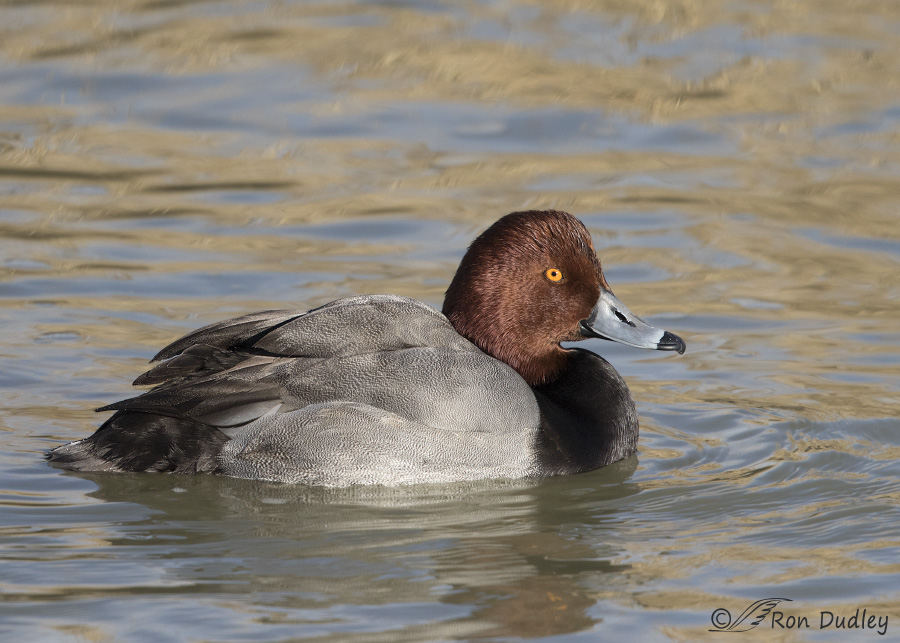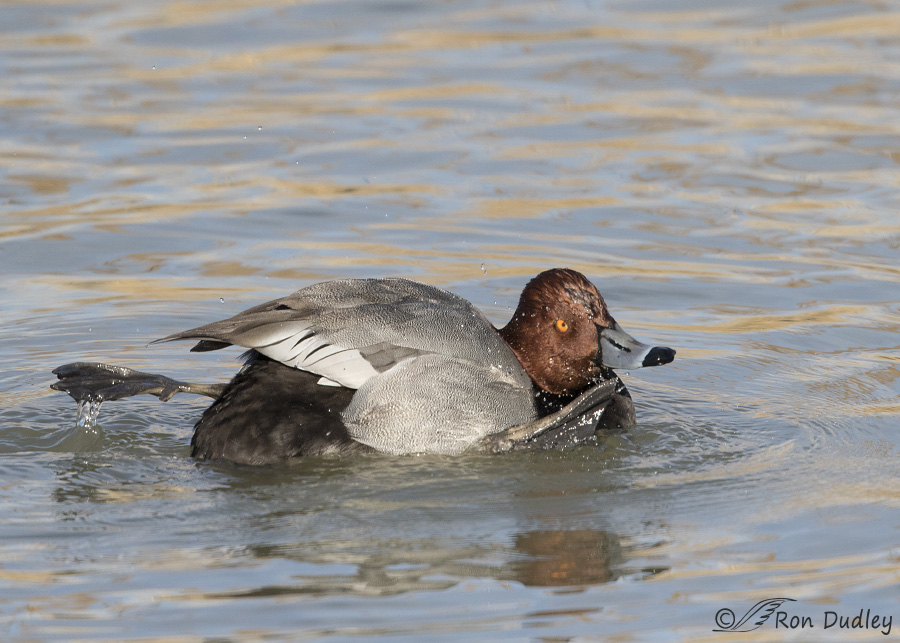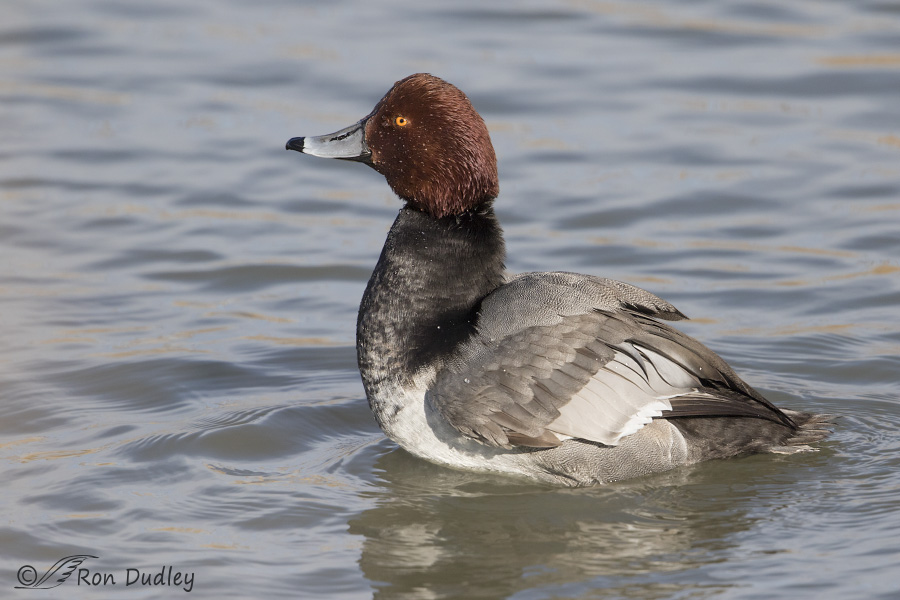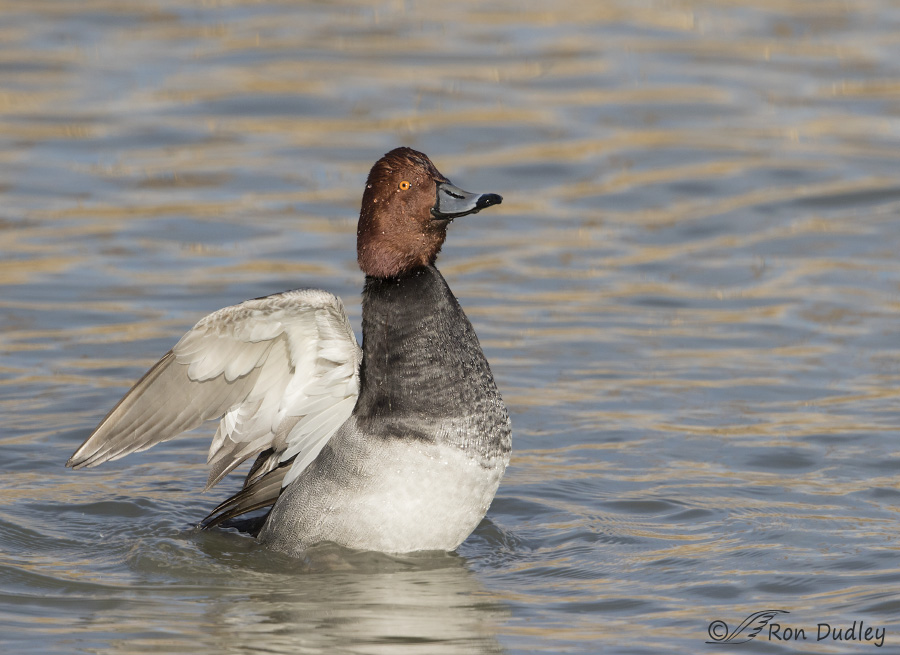Clearly I don’t post ducks as often as I should. This morning’s post is an effort to partially rectify that situation.

1/3200, f/6.3, ISO 800, Canon 7D Mark II, Canon EF 500mm f/4L IS II USM + 1.4 tc, not baited, set up or called in
In my view the only ducks that I see regularly that approach the elegance of male Pintails and Canvasbacks are the handsome Redheads. Though quite similar to Canvasbacks the black tipped blue-gray bill with a white subterminal band of the Redhead drake gives it a distinctive flair that I admire. I photographed this male just over a week ago at Farmington Bay WMA. Much of the time he just floated around the pond looking handsome and a little haughty, which made me think of the following quote from humorist Mark Twain:
- “When red-headed people are above a certain social grade their hair is auburn.”
Perhaps the quote also applies to ducks. He certainly seemed somewhat aloof from the other birds on the pond and the reddish-brown color of his head could easily be described as auburn. But the name “Auburnhead” just wouldn’t have quite the same ring to it…

1/4000, f/6.3, ISO 800, Canon 7D Mark II, Canon EF 500mm f/4L IS II USM + 1.4 tc, not baited, set up or called in
That’s not to say he didn’t lose some of his dignity and look a little goofy at times. Twice when he scratched his head with one foot he stuck out his alternate leg and foot behind him in a sort of awkward balancing act that reminded me a little of a typical grebe pose.

1/3200, f/6.3, ISO 800, Canon 7D Mark II, Canon EF 500mm f/4L IS II USM + 1.4 tc, not baited, set up or called in
Redheads are diving ducks but this pond is shallow enough that when he was feeding he acted more like a dabbler and fed from the surface. When he would raise his head out of the water he would often rise up from the surface slightly and give a little shake but it was always less vigorous (and more dignified) than I’ve come to expect from most aquatic birds.
I’d have preferred to have more room at the top of the frame in this shot but the image is full frame and I chose not to add canvas.

1/5000, f/6.3, ISO 800, Canon 7D Mark II, Canon EF 500mm f/4L IS II USM + 1.4 tc, not baited, set up or called in
Several times he gave me a wing flap during the shaking process but usually when he did it there was a small but annoying patch of phragmites between me and the bird. He seemed to move into that position before he flapped just to aggravate me. Thankfully our recent heavy snow has knocked that phrag patch down so it will no longer be a problem.
In fact, most of the Farmington phrags have now been flattened by the snow. It looks like a completely different place now and I enjoy the change of scene and the more expansive vistas.
Ron
Note: Redhead hens are notorious for nest parasitism – to the point that they’re sometimes called “parasite queens”. Personally I find it curious that they’re not vilified for the practice to the extent that Brown-headed Cowbirds are. In both cases it’s a natural behavior so I have no problem with it (and yes, I’m aware of the effects of cowbird nest parasitism on Kirtland’s Warblers and other songbird species…)


Thanks for the Duck pictures they are my favorite.
I know you love ducks, Bridger. I still remember running into you out at Farmington several years ago, freezing your butt off but having a wonderful time hunting on Unit 1. I ran into your mother at the nursery last summer and checked up on you and your sister. Sounds like you’re both doing well.
Ol Red is gorgeous. Love the quote.
Thanks, Jean.
Hi Ron!
Great photo’s Your colors and details are so beautiful! Still praying for Shannon recovery and you and the family!
Was bitter cold this am! winds was blowing! No snow for Christmas they say! Have a great night!
Well, cold still beats the 70’s you were having a few days ago, seems to me. I wish you snow for Christmas – “they” are wrong at least as often as they are right.
An absolute stunner.
Love the Mark Twain quote too. A wise and very funny man. Not a combination we see a lot of now.
I enjoy Twain a lot too, EC. As you know I live in Utah. Twain visited Utah Territory in the 1860’s and he had some very interesting observations about the early Mormons out here back then. I go back and read them occasionally just for the fun of it.
Wonderful shots Ron! Thanks for sharing!
Charlotte
Thank you, Charlotte.
I used to be Auburn-headed until I went “blond”. And I have done my share of looking goofy.I think the reason most people don’t like cow birds too is the baby cowbird once hatched will push out other eggs and chicks in the nest. The redheaded ducklings seem to live harmoniously with the with their foster siblings.
“The redheaded ducklings seem to live harmoniously with the with their foster siblings.”
That may be true to some extent, April, but apparently there are significant “negative” effects of the brood parasitism of Redheads on the host species largely before the ducklings are hatched.
BNA Online reports significant negative effects on clutch size, nest success, brood size and duckling survival of the host species when parasitized by Redheads. Their data is too voluminous to report here but if you have access to BNA you might want to check it out.
Just checked out the Redhead Duck with regard to whose nests it parasitizes, and it turns out that the birds are of a similar size as adults, so I’m assuming the babies would also be of similar size. Much less problematic for those species than for some of the tiny song birds who are the targets of Brown-headed Cowbirds.
Susan, that difference makes sense.
Precocious birds like ducks leave the nest immediately and feed themselves so there would be little competition for food amongst the youngsters of different species hatched in the same nest. Altricial birds like most songbirds (including cowbirds) are helpless for weeks in the nest and must be fed by the parents so the generally larger cowbirds in the nests would have significant advantage.
Nice series. I’m glad that such a handsome bird has the ability to look goofy – perfection is boring. The only bird I’ve been aware of prior to this as a nest parasite is the Brown-headed Cowbird. Your note about nest parasitism made me smile, as I know I’ve commented on difficulties I’ve had with that behavior. In thinking about the subject today, I’ve realized that human activity that results in reduced populations of certain birds probably has something to do with why many view nest parasitism as a problem. I’ll have to check to see whose nests the Red-headed Duck uses. You’ve got me curious now.
The only bird I’ve been aware of prior to this as a nest parasite is the Brown-headed Cowbird. Your note about nest parasitism made me smile, as I know I’ve commented on difficulties I’ve had with that behavior. In thinking about the subject today, I’ve realized that human activity that results in reduced populations of certain birds probably has something to do with why many view nest parasitism as a problem. I’ll have to check to see whose nests the Red-headed Duck uses. You’ve got me curious now.
Curiosity is generally a good thing (except for that cat that was killed by it…)
In the third and fourth shots, it looks like his collar is too tight…Wood ducks’ collars fit perfectly…..
That first shot is a beauty! Real “essence of duck”…I was surprised you didn’t mention the male Wood Duck”…don’t you hsve them oit there? The first time I saw one, I thought it was too beautiful to be real, Although I agree that the ducks you mentioned are very handsome, I think the male Wood duck blows them all out of the water……
I think of Wood ducks as “Aqua Peacocks”….
Patty, Male Wood Ducks are much too gaudy for my tastes for them to be at or near the top of my list. I prefer much less flash. I like them but I prefer the females and I feel the same way about Northern Cardinals (in preferring the females).
There’s no accounting for taste, huh?
I understand…i prefer the female Cardinal’s coloration, too…and, for the same reason, love the Chickadee, Cedar Waxwing, and Canada geese….
It is a beautiful bird and the detail and actions you captured are great! I’ve never thought of a duck doing the nest parasitism thing – always get an education along with great pictures.
I’ve never thought of a duck doing the nest parasitism thing – always get an education along with great pictures. 
Judy, many ducks, weavers and cuckoos are nest parasites, among others. I’ve seen estimates that approximately 1% of all bird species are parasites. If you round off the total number of species to 10,000 that’s about 100 species of parasitic birds.
NOW THAT IS JUST THE PICTURE FOR A CARVING!!!
Of course I can say that about many of your shots, but since I carve ducks, or use to, that is where my head is at.
Beautiful shots that any carver would love to have in his/her reference file before carving this male.
Great shots Ron!
Ha, I thought of you and your carving when I was composing the post, Dick. Carve away if you like. You’ve been such a huge supporter of my blog that I’d be honored if you ever chose to do so. Some folks don’t get permission first and that’s when I get on my infringement bandwagon…
I’d require a photo of the finished piece though…
Gee, I just might take you up on that = I’ll be in touch!
Understand this isn’t a complaint, just a fact – I thought I was busy when I was teaching, but since retirement, I find that I am always busy, but at my pace! LOL!!!
I know EXACTLY how you feel about retirement, Dick. I’m at least as busy since I retired as I was when I was teaching (though I’ll admit to the luxury of an almost daily nap these days…)